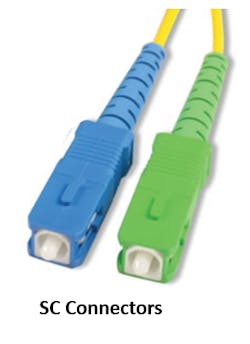101 Series: Know Your Fiber Connectors
Fiber optic connectors include plugs that feature a protruding ferrule that holds the fiber in place and an associated adapter for aligning and mating fibers to form a connection point. The first ferrules introduced in the 1970s were comprised of metal or a hard plastic, and then in the mid-1980s, the introduction of the ceramic ferrule improved alignment and allowed for lower insertion loss.
Over the past several decades, the market has seen the introduction of various fiber optic connectors aimed at providing lower insertion loss performance, lower cost, higher density and/or easy termination. In fact, according to the Fiber Optic Association, in all there are about 100 different types of fiber optic connectors. Thankfully you don’t need to know the ins and outs of all of these types of connectors since there are just a handful that make up the majority of what you might come across in today’s cabling plants. These standard-compliant connectors are covered by EIA/TIA-604 Fiber Optic Connector Intermateability Standards (FOCIS).
Let’s take a closer look at the types you might come across and how they differ.
SC, FC and ST fiber optic connectors all feature a 2.5mm ferrule size and can therefore be mixed and matched using special hybrid adapters. Developed by Nippon Telegraph and Telephone (NTT), the SC connector is easily recognized by its square shape. It features a snap-in design that mates using a push-pull action with a spring-loaded ferrule. Available as simplex or duplex, the SC is covered by TIA-604-3 (FOCIS-3), and due to its excellent insertion loss performance and fast deployment, it dominated as the connector of choice well into the 1990s. It still likely remains the second most common fiber connector type for simplex and duplex applications.
Covered by TIA-604-2 (FOCIS-2), the ST connector type was introduced by AT&T in the early 2000s. It is a spring-loaded connector that looks very similar to the FC but uses a bayonet design instead of a threaded screw. This quick connecting bayonet design originally made ST connectors popular for campus, enterprise and military multimode networks, but because it does not support an angled polish (i.e., APC) preferred for today’s telco and FTTX singlemode deployments (you can read more about that here), its use has declined considerably over the past decade.
The Small Form Factor
The fiber connector you likely hear about the most these days is the MPO (multi-fiber push on) connector that supports higher-speed multi-fiber applications such as 8-fiber 40 and 100 Gig applications that transmit at 10 or 25 Gbps over 4 fibers and receive at 10 or 25 Gbps over 4 fibers. For space savings and manageability, the MPO is also often also used for backbone duplex fiber applications where the MPO is broken out to a duplex connector types such as LCs or SCs using cassettes or fan-out assemblies.






